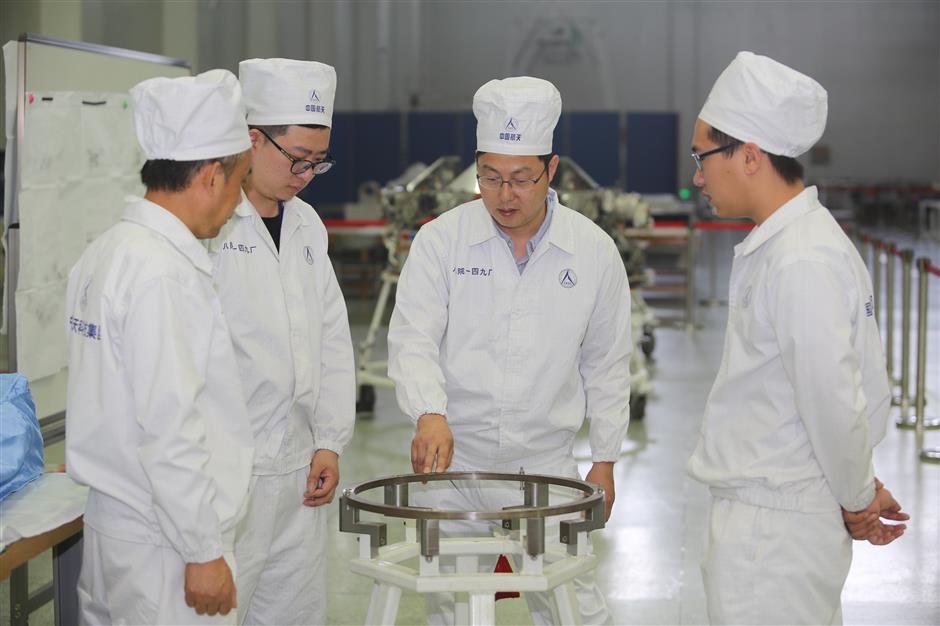From factory floor to the stars
Wang Shuqun was holding his breath as China’s Shenzhou-8 spacecraft approached the Tiangong-1 space laboratory orbiting above the Earth.
On November 3, 2011, China completed its first space docking. Wang, 47, was the chief fitter behind the docking system. He is the chief technician at the Shanghai Academy of Spaceflight Technology and special technician at the Shanghai Aerospace Equipments Manufacturer.
With the successful docking, China became the third country in the world to master space rendezvous and docking technology, after Russia and the United States.
It also marked China entering the second phase of the three-step China Manned Space Engineering Project, which was proposed in 1992. And the landmark also helped pave the way for the third step — to launch and establish a fully China-grown space station.
The docking in 2011 took only a few minutes, but Wang had been working on it for 16 years.
“It felt like seeing off your child to gaokao (the national college entrance examination),” says Wang. “The system to some extent is our child. After working hard for years and conducting various tests in the lab, he was taking the most important test in his life.”
Wang started to work as a fitter in a machinery factory in Shanghai's Minhang District when he was 19. The factory was later known as the Shanghai Aerospace Equipments Manufacturer, one of the most important space manufacturing bases in China.
“At that time, I was very young, without big ambitions like dreaming of space,” Wang says. “I chose the factory mainly because it was close to my home.”
Also because of the closeness, Wang would immediately ride on his bike to the factoy when there was anything wrong in the laboratory, even at midnight.

Three years after China unveiled the three-step strategy, the space docking project was launched in 1995.
“The most difficult thing is to start from nothing,” says Wang. “Because none of us had done this before, there was no standard or material to refer to. We had to explore everything ourselves.”
Wang and his team’s job was to assemble tens of thousands of components of the docking system in the right place, including 118 sensors, 291 gears, 759 bearing parts and more than 11,000 fasteners.
The docking had to be stable and precise to within a millimeter as the lab and the spacecraft moved at 7.9 kilometers per second, otherwise the contact pins might be damaged and signals between space and the ground could be lost.
“We thought it would take only two to three years, but in the end, it took nearly 16 years,” he says. “Many unexpected challenges got in the way.”
One of the biggest challenges was that the 12 connection locks could not separate as designed, which troubled the team for nearly two years.
To make two roughly 8-ton modules pair in space, the key lies in the 12 locks. They must lock and separate at the precisely the same time.
After rounds of review, the issue was located in assembly, but no one knew what caused it. After about a year of tests, Wang finally found the “troublemaker” — the malleability of the steel cable. The weakening tension of the cables resulted in the locks being unable to sync. Wang then suggested changing the rotation direction of the cables and adjusting the method used in the sync process.
As with other lessons learnt through the development process, the technique was written into the assembly standards for the docking system, which provided the basis for other technicians to work on in the future.
After the first successful docking, China completed another three dockings — in 2012, 2013 and 2016 — including the first manned space docking last year.
During the interview, the experienced technician outlined his lessons for young technicians.

Wang Shuqun (second from right) works with his colleagues.
“Compared with many other aspects, human factors have a larger influence in space manufacturing,” says Wang. “Because our components are usually made in a small quantity or even a single one, we cannot use an assembly line to standardize the process.”
Wang says that, like many technicians, he was good at doing the work, but struggled with expressing the ideas behind it. However, after years of training younger technicians and writing related materials, he has mastered this field.
“I feel our values not only lie in getting things done, but more importantly in our experience. Both the technicians and our employer have paid a lot to learn these lessons from making mistakes, and it would be a waste to leave that within ourselves,” he notes.
Over the past few years, Wang has completed 15 essays, had five patents approved and written the textbooks and guides for rocket fitters. He has also launched a workshop to give young technicians on-the-job training with other experienced technicians in the factory, including how to apply for patents and write the application documentation.
“The society is paying increasing attention to innovation from front-line workers. I hope we are not only passing on skills to the young technicians, but also the ability to sum up their own innovation achievements and pass them on,” he says.
“We have about 1,400 workers, with about half of them technicians. If 100 of the technicians can be motivated, the factory’s innovation capacity in general will improve greatly.”
Wang says over the past some 10 years, China’s space industry has been developing at a rapid pace, and front-line technicians’ incomes have also increased greatly.
Now, Wang and his team are working on China’s space station project to achieve the final phase of the three-step national space strategy — a manned space station.
















